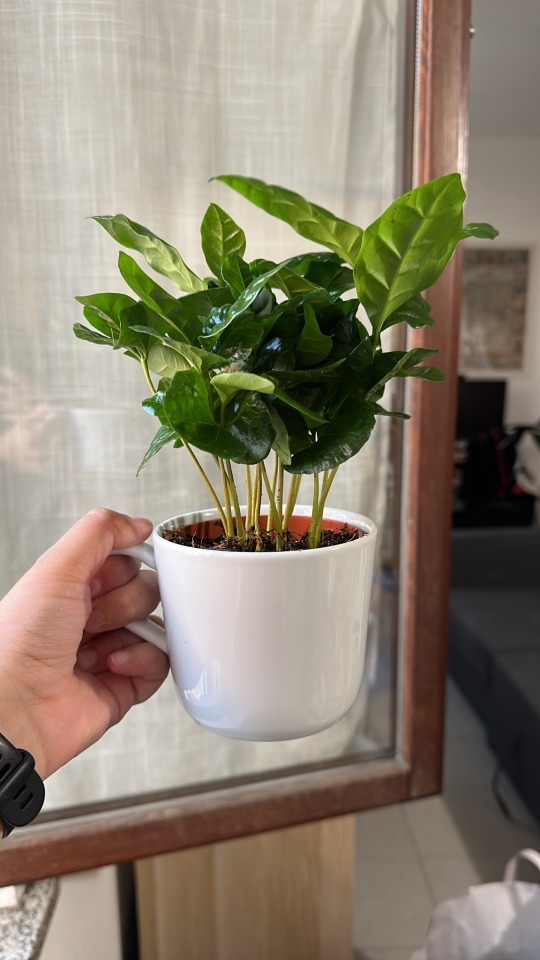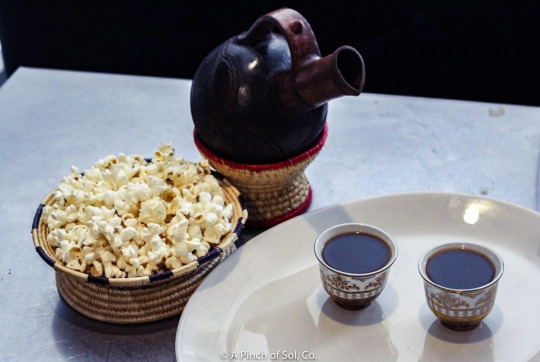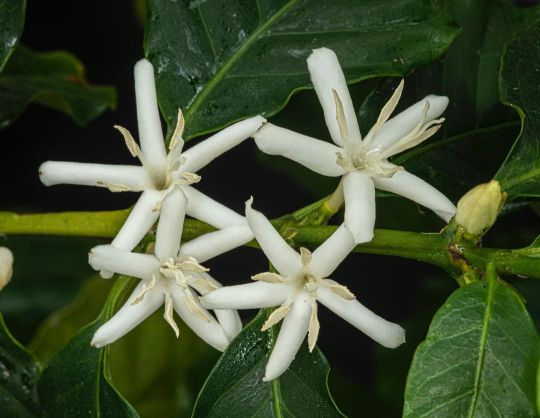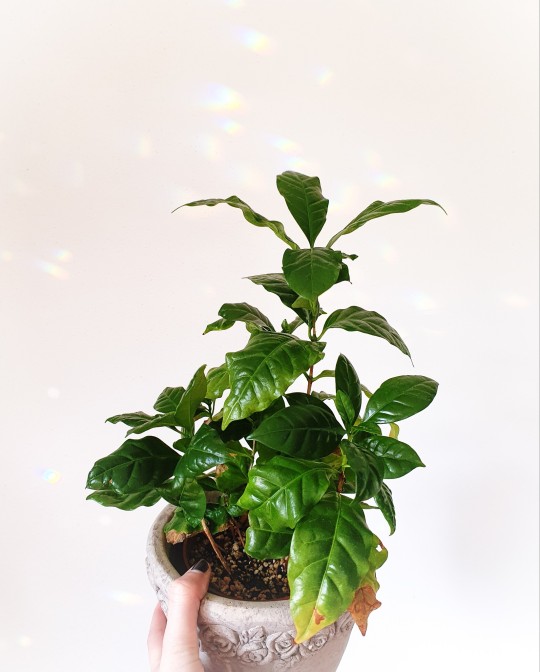#coffea
Text

Grace Kelly at the set of Rear Window (1954)
59 notes
·
View notes
Video
Coffea arabica by Richard Ellis
Via Flickr:
Coffea arabica is the species responsible for 60% of the coffee produced. It is endemic to the highlands of Ethiopia but is cultivated in many countries throughout the tropics. It is, however, considered an invasive weed in parts of Sri Lanka and Australia. #CoffeePlant #CoffeeFlowers #Coffeaarabica #Coffea #arabica #CUgreenhouse #botany
5 notes
·
View notes
Text

Lina Kusaite
#coffee#coffee plat#lina kusaite#Coffea#Coffea arabica#Arabic coffee#arabica#cocoon characters#coffee berry#coffee flower#botanical illustration
6 notes
·
View notes
Text
Eating Weeds: Cleavers Coffee
Eating Weeds: Cleavers Coffee
One of the world’s most beloved beverages comes from a species of plant found in the fourth largest family of flowering plants. Rubiaceae, also known as the coffee or bedstraw family, consists of around 13,500 species, placing it behind just Asteraceae, Orchidaceae, and Fabaceae for the most number of species. Coffea arabica, and other species in the genus Coffea, are grown for their fruits which…

View On WordPress
#agriculture#bedstraw#cleavers#Coffea#Coffea arabica#coffee#eating weeds#flowers#fruits#Galium#Galium aparine#introduced plants#leaves#plant dispersal#plant hairs#plant science research#plants#Rubiaceae#seed dispersal#tea#trichomes#weeds
19 notes
·
View notes
Text

Coffea arabica
1 note
·
View note
Text
Vivi Argentina madura
Black stripper gets his hard cock sucked by slutty chicks
Teen hotties play with shaved cookies for the sake of orgasm
Bi Girls Leather and Lace
Duas gatinhas gostosas flagradas na rua
Abductions with redemption based on sex
Mandii Marie gets her tight little asshole played with before she shoves her large buttplug in it
Babes Zoey and Gia adores scissor sex and pussy licking
Latina squirts all over dildo
Threesome lesbian spanking and fucking
#tridymite-trachyte#quaesita#algebraizing#chirality#crowd#pyromanias#annoying#agasp#Gaboriau#nematocide#pazazzes#demob#foilsman#Coffea#argyria#pyrometric#boyars#nonbiting#constipated#cobego
0 notes
Text

Ho -finalmente- comprato una piantina da tenere sulla scrivania in ufficio.
È una piantina di caffè e ovviamente si chiama Lorelai Victoria Gilmore.
4 notes
·
View notes
Text

A Crash Course in Ethiopian and Eritrean Coffee Tradition
Typically, the woman of the household (or waitress if you’re dining in a restaurant) performs the ceremony for her guests. First, fresh Ethiopian coffee beans roast over a small open furnace. In order to ensure an even roast, the host continuously turns the beans. As she turns the beans, your nose is filled with the aroma of fresh coffee intermingled with hints of fruit and flowers. Once the beans are evenly roasted, the host passes the pan of roasted beans in front of everyone’s face – giving you a better smell of the emitting fragrances. The smell is nothing like what you would expect. Unlike the smell of coffee from your local Starbucks, this Ethiopian coffee has a fruity, sweet smell that just warms your soul. The host then pours the beans into a wooden bowl called a mukecha. The mukecha is used to grind the beans by hand. Finally, the coffee grounds are poured into a jebena, which is a pot is made of thick clay and a long pouring spout. The jebena is extremely functional in that it ensures the coffee grounds don’t burn over the open furnace. Water is added to the jebena and then the mixture is boiled.
After a few minutes of boiling, the coffee is ready to be poured into small, decorative ceramic cups. The host pours the coffee into the cups in one single pour – by that I mean, the host does not put the jebana down in an upright position until every cup is filled with coffee, which I found extremely intriguing. There had to be some significance in pouring all the coffee at once, right? I was always taught to ask about things I don’t understand, so I just had to ask my waitress about the purpose of pouring all the cups of coffee simultaneously. My waitress explained that pouring the coffee all at once was a very important step in the ceremony. Doing so ensures that the coffee grounds do not mix back into the beverage and stay at the bottom of the jebena – giving you the perfect cup of fresh coffee.
The ceremony does not stop there, however. Shareable platters of himbasha (sweet bread), yellow raisins and popcorn were brought to the table. As I began to take pictures, my waitress told me to “enjoy the experience” and to “take pictures later”. I respectfully put my camera down and started to take it all in. Looking at the large plates filled with common snacks, it became prominently clear to me that family time and sharing was a very important piece of the Ethiopian and Eritrean culture. These ceremonies are a time when individuals tune the outside world out and get to know each other just a little better. This experience opened my eyes to how valuable our time is with those we love and care about.
#p#txt#tea time#mindfulness#herbarium#Coffea arabica#decaf coffee#coffee#tradition#culture#sidewalkchemistry
5 notes
·
View notes
Text
mugiwaras as ovenbreak cookies
monkey d. luffy - captain BBQ cookie/mugiwara cookie
roronoa zoro - onigiri cookie
usopp - sniper king cookie
sanji - salt chef cookie
nami: tangerine cookie
tony tony chopper: doctor love cookie
franky: mecha-cola cookie
nico robin: coffea cookie
brook: soul cookie
jinbei: sea knight cookie
#paint.txt#cookie run ovenbreak#one piece#straw hat pirates#yeah i could have been more creative with pretty much everyone. but also look at franky. and robin. and brook. those are perfect#mecha-cola is a wonderful pun. coffea is literally the coffee flower. SOUL REFERS BOTH TO THE YOMI YOMI NO MI AND SOUL MUSIC#and then i just kind of. petered out with jinbei. sorry. im not at wano yet
7 notes
·
View notes
Text

Coffee plant; coffea arabica
5 notes
·
View notes
Text

#412#café#cafe#laboratorio#sociedade#fisica#quimica#biologia#arte#humanas#coffea arabica#cafeina#cafeína#cafestol#kahweol#celsius#poesia
0 notes
Photo

Coffee flowers (Coffea arabica). These flowers only last a few days before they start looking past their prime and mealybugs adore them.
3 notes
·
View notes
Text


🌱 coffea arabica
I gotta say, I'm pretty proud of myself for being able to keep my coffee alive for quite some time now! Yes, there is some crustyness but it's all only on the older leaves.
#coffee#coffee plant#coffea arabica#plant#plants#houseplant#indoor plants#pflanze#urban jungle#MY PLANTS#MY PICS#MINE
1 note
·
View note
Text


As we got closer to Eurospin, we started remembering that we Have made a few cups with this brand. I remember, it’s a dark roast and not that good. The Todis one is a medium dark roast and tastes better. But, this brand tastes better than the Tuodi brand.
0 notes
Photo

Coffea Arabica Seeds (Arabian Coffee Seeds) Organic Tropical Fruit Seeds, NonGMO B5 Coffea Arabica is mostly known under the common name Arabian coffee, Brazilian coffee, or Kofi coffee and belongs to the Rubiaceae family, and originated in Ethiopia. Coffea Arabica is easy to grow indoors, makes a very attractive houseplant and if it likes you well enough, it will even reward you with flowers and berries! It is a terrific conversation piece! Arabica represents approximately 90 percent of the world's coffee production. Coffee (Coffea Arabica Nana) - Wouldn't it be nice to grow your own coffee house plant from coffee seeds? Coffea arabica nana is a dwarf bush with beans that contain caffeine, theophylline and theobromine. The beans are dried, roasted, and ground, and then extracted with water to produce coffee. Coffea arabica is a species of coffee bush that produces arabica coffee, accounting for the majority of the coffee consumed in the world. This species of the bush is the oldest known bush to be cultivated for coffee production. Until the beginning of the 20th century, it was virtually the only type of tree from which coffee was harvested commercially. The Arabica plant is an evergreen, typically large upright bush, or a small tree that can reach a height up to 20 feet or 3-5 ft in the container. On plantations, it is kept at a height of about 2-3 m (6 ft) to facilitate harvesting. After planting, the Arabica trees produce their first crop in three years and will be bearing fully at 7-8 years old. The Arabica plant can successfully produce fruits for about 40 years. Primary, non-renewable branches grow from the trunk at an average distance of 15 cm. The Arabica plants have taproots that are not very deep. The bright green oval leaves are opposite, shiny on top and glossy dark on the underside. The branches carry bouquets of 5-10 small white flowers, in axillaries clusters, opening simultaneously during spring and summer. The white flowers have 5 petals with an odoriferous fragrance that spreads over the plantations. After 7-9 months, the flowers give way to the oval-elliptic coffee cherries, yellow to crimson when ripe and black upon drying, with two beans side-by-side. Each tree can produce 8-10 pounds of coffee a year, depending on climate conditions and other factors. Coffea Arabica is easy to grow indoors, makes a very attractive houseplant and if it likes you well enough, it will even rewards you with flowers and berries! Coffea Arabica is mostly known under the common name Arabian coffee, Brazilian coffee, or Kofi coffee and belongs to the Rubiaceae family, and originated in Ethiopia. Coffea Arabica is easy to grow indoors, makes a very attractive houseplant and if it likes you well enough, it will even reward you with flowers and berries! It is a terrific conversation piece! Arabica represents approximately 90 percent of the world's coffee production. The Arabica plant is an evergreen, typically large upright bush, or a small tree that can reach a height up to 20 feet or 3-5 ft in container. On plantations, it is kept at a height of about 2-3 m (6 ft) to facilitate harvesting. After planting, the Arabica trees produce their first crop in three years, and will be bearing fully at 7-8 years old. The Arabica plant can successfully produce fruits for about 40 years. Primary, non-renewable branches grow from the trunk at an average distance of 15 cm. The Arabica plants have taproots that are not very deep. The bright green oval leaves are opposite, shiny on top and glossy dark on the underside. The branches carry bouquets of 5-10 small white flowers, in axillaries clusters, opening simultaneously during spring and summer. The white flowers have 5 petals with an odoriferous fragrance that spreads over the plantations. After 7-9 months, the flowers give way to the oval-elliptic coffee cherries, yellow to crimson when ripe and black up on drying, with two beans side-by-side. Each tree can produce 8-10 pounds of coffee a year, depending on climate conditions and other factors. Hardiness Zones : 9-11 (-5c/25f, 4c/40f). The Arabica prefers partial shade, and likes a moist rich soil. The plant needs protection from frost. Give the roots room to grow. They tolerate a wide range of pH. but optimal pH has been suggested as 4.5-7.0. The type of soil is not too important but good drainage is a must. This plant likes high humidity, so if in dry conditions, give it an occasional misting. When it is grown indoor, place it close to a bright window. Hardiness Zones : 9-11 (-5c/25f, 4c/40f). The Arabica prefers partial shade and likes moist rich soil. The plant needs protection from frost. Give the roots room to grow. They tolerate a wide range of pH. but optimal pH has been suggested as 4.5-7.0. The type of soil is not too important but good drainage is a must. This plant likes high humidity, so if in dry conditions, give it an occasional misting. When it is grown indoors, place it close to a bright window. Count: 5 Season: Perennial USDA Zones: 8 - 10 Height: 12 inches Bloom Season: Mid-spring Bloom Color: White Environment: Partial shade Soil Type: Well-drained soil with pH 6.1 - 6.5 Deer Resistant: Yes House Plant: No Latin Name: Coffea Arabica Temperature: 80 - 85F Average Germ Time: 60 - 90 days Light Required: Yes Depth: Sow seeds 1/2 inch deep Sowing Rate: 1 seed per plant Moisture: Soak seeds overnight before planting. Seeds should not be kept too moist and allowed to almost dry out between watering Plant Spacing: 18 inches Coffea Arabica - Grow Coffea arabica in different types of soil -- clay, sand, loam, acidic or alkaline -- as long as the ground is well aerated and the site provides partial shade. Build a 3 to 4 inch mulch ring around the coffee shrub. Use compost, grass clippings or other organic mulch to slow evaporation and suppress weeds. The matter also provides nutrients as it decomposes. Irrigate the plant to maintain the root zone moistly. Coffee plants have only moderate drought tolerance. Feed the Coffea arabica shrub an all-purpose, slow-release fertilizer in spring. Spread it around the plant's base according to the rates listed on the manufacturer's label. Water in the nutrient. Prune the shrub to control its height, especially if you plan to harvest the berries. Remove dead, diseased, and broken twigs. Make pruning cuts at 45-degree angles, 1/4 inch above buds. Slant the cut upward. Saw the trunks of old coffee shrubs back to 1 foot from the ground to rejuvenate the plants. Cover the cuts with pruning paint to prevent infection. The stems regrow with renewed vigor after a hard pruning Germination Plant indoors before the last frost. Coffee seeds do not need a cold period to germinate. As soon as you receive them, they should be soaked in water for 24 to 48 hours. Then, plant the seeds at 3/4" depth in a deep pot, using a rich, moist, well-draining soil mix. Peat moss in the potting mix will help provide acid conditions. Keep the seedlings at 30C and provide bottom heat. The soil should be kept on the moist side, but never soggy and in filtered sunlight. The seeds need air circulation, so do not cover them with plastic. Raise the seedlings in shade for 6-12 months, and then harden them off to the sun. Germination should occur in about 60 days, but it can take longer. Be patient! Food Coffee plants will produce fruit without any fertilizing whatsoever, but for best results and maximum yield, they should be fed every 2 weeks from March to October, and then monthly from November through February. Use a soluble, all-purpose (10-10-10) fertilizer. Pruning may involve simple pinching to produce a bushier plant, or you may go as far as cutting it way back... Right down to where only two branches near the bottom are left on it! Scarification / Stratification No How to Sprout Coffee Seeds Once you have your seeds, soak them in water for 24 hours, drain, and then sow in damp sand or wet vermiculite, or put the seed between moist coffee sacks. After you germinate coffee tree seeds, remove them from the medium. Place the seed flat side down in a hole made in loam soil with a high humus content to which rotted manure, bone meal or dried blood can be added. You can also try a lightweight, porous soil. Don’t press the soil down. Place ½ inch (1 cm.) of mulched grass atop to conserve moisture but remove it when the seed has germinated. Water seeds daily but not too much, just moist. Once your seeds have germinated, the plant can either be left or transplanted in a porous, low pH soil with a high nitrogen content. Orchid fertilizer may be used sparingly on the coffee plant to maintain the low pH and add minerals. http://springsofeden.myshopify.com/products/coffea-arabica-seeds-arabian-coffee-seeds-organic-tropical-fruit-seeds-nongmo-b5-1
#Coffea Arabica Seeds#Arabian Coffee Seeds#Tropical Fruit Seeds#coffee seeds#Turkish Coffee#Arabian Coffea#coffee tree seeds#Coffea Arabica#Arabian Coffee Tree#organic seeds
1 note
·
View note
Text
It’s never too late for coffee…!!

COFFEE DATES BACK TO 800 A.D…! LEGENDS ARE TOLD THAT GOAT HERDERS SAW THAT THEY’RE GOATS STRTED TO “DANCE” AFTER EATING FRUIT OF THE COFFEA PLANT…! coffee is a fruit cause it has seeds…
62 notes
·
View notes
